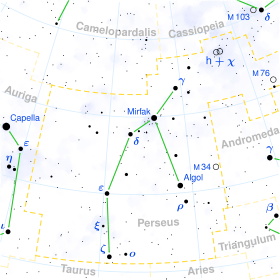24 Persei
24 Persei is a star in the northern constellation of Perseus, located around 337 light years from the Sun. It is visible to the naked eye as a faint, orange-hued star with an apparent visual magnitude of 4.94.[2] The object is moving closer to the Earth with a heliocentric radial velocity of −37 km/s.[5]
| Observation data Epoch J2000 Equinox J2000 | |
|---|---|
| Constellation | Perseus |
| Right ascension | 02h 59m 03.67639s[1] |
| Declination | 35° 10′ 59.2865″[1] |
| Apparent magnitude (V) | 4.94[2] |
| Characteristics | |
| Spectral type | K2III[3] |
| U−B color index | +1.28[4] |
| B−V color index | +1.25[4] |
| Astrometry | |
| Radial velocity (Rv) | −36.97[5] km/s |
| Proper motion (μ) | RA: −45.920[1] mas/yr Dec.: +5.632[1] mas/yr |
| Parallax (π) | 9.6661 ± 0.1963[1] mas |
| Distance | 337 ± 7 ly (103 ± 2 pc) |
| Absolute magnitude (MV) | -0.32[2] |
| Details[6] | |
| Mass | 1.59 M☉ |
| Radius | 23.56 R☉ |
| Luminosity | 185 L☉ |
| Surface gravity (log g) | 1.91 cgs |
| Temperature | 4,391 K |
| Metallicity [Fe/H] | −0.07 dex |
| Rotational velocity (v sin i) | < 1.9[7] km/s |
| Other designations | |
| Database references | |
| SIMBAD | data |
This is an aging giant star with a stellar classification of K2 III,[3] which indicates it has exhausted the hydrogen at its core and evolved away from the main sequence. It has 1.59 times the mass of the Sun and has expanded to about 24 times the Sun's radius. The star is radiating 185 times the Sun's luminosity from its enlarged photosphere at an effective temperature of 4,391 K.[6]
References
- Brown, A. G. A.; et al. (Gaia collaboration) (August 2018). "Gaia Data Release 2: Summary of the contents and survey properties". Astronomy & Astrophysics. 616. A1. arXiv:1804.09365. Bibcode:2018A&A...616A...1G. doi:10.1051/0004-6361/201833051. Gaia DR2 record for this source at VizieR.
- Anderson, E.; Francis, Ch. (2012). "XHIP: An extended hipparcos compilation". Astronomy Letters. 38 (5): 331. arXiv:1108.4971. Bibcode:2012AstL...38..331A. doi:10.1134/S1063773712050015. Vizier catalog entry
- Hoffleit, D.; Warren, W. H. (1995). "VizieR Online Data Catalog: Bright Star Catalogue, 5th Revised Ed. (Hoffleit+, 1991)". VizieR On-line Data Catalog: V/50. Originally Published in: 1964BS....C......0H. 5050. Bibcode:1995yCat.5050....0H.
- Mallama, A. (2014). "Sloan Magnitudes for the Brightest Stars". The Journal of the American Association of Variable Star Observers. 42: 443. Bibcode:2014JAVSO..42..443M.Vizier catalog entry
- Famaey, B.; Jorissen, A.; Luri, X.; Mayor, M.; Udry, S.; Dejonghe, H.; Turon, C. (2005). "Local kinematics of K and M giants from CORAVEL/Hipparcos/Tycho-2 data". Astronomy & Astrophysics. 430: 165. arXiv:astro-ph/0409579. Bibcode:2005A&A...430..165F. doi:10.1051/0004-6361:20041272.
- Reffert, Sabine; Bergmann, Christoph; Quirrenbach, Andreas; Trifonov, Trifon; Künstler, Andreas (2015). "Precise radial velocities of giant stars". Astronomy & Astrophysics. 574: A116. arXiv:1412.4634. Bibcode:2015A&A...574A.116R. doi:10.1051/0004-6361/201322360. hdl:10722/215277. Vizier catalog entry
- De Medeiros, J. R.; Mayor, M. (1999). "A catalog of rotational and radial velocities for evolved stars". Astronomy and Astrophysics Supplement Series. 139 (3): 433. arXiv:astro-ph/0608248. Bibcode:1999A&AS..139..433D. doi:10.1051/aas:1999401. Vizier catalog entry
- "24 Per". SIMBAD. Centre de données astronomiques de Strasbourg. Retrieved 2019-03-29.
This article is issued from Wikipedia. The text is licensed under Creative Commons - Attribution - Sharealike. Additional terms may apply for the media files.
